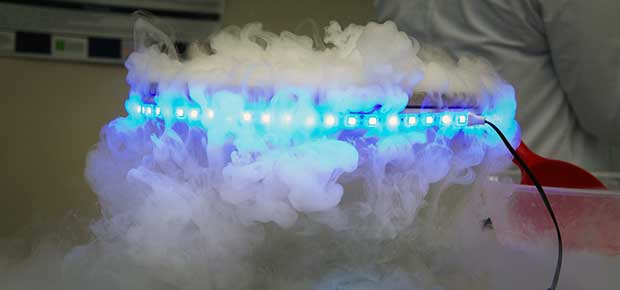


June 23 2016 | Kent & Medway | Views: 1762
On the Thursday 23 and Friday 24 June 300 school students from 21 Secondary schools in Kent and Medway region took part in Chemistry at Work event at Canterbury Christ Church University. The event shows how the chemistry studied at school is put into use in the real, everyday world. The event is organised by Kent & Medway STEM who hold the contract for STEMNET at Canterbury Christchurch University, who have hosted the event for the past five years on behalf of Royal Society of chemistry.
Chemistry at Work aims to introduce school students to their local chemical industry and to demonstrate how the chemistry they are learning at school is used by a variety of people in their workplace. The presenters represent a wide range of companies and organisations from the local area. Through interactive presentations they will explain applications of chemistry in an interesting and interactive way.
The students’ feedback included:
The workshops were varied and included diverse presentations such as: ‘What’s wrong with Tom?’ by Pearson Growers Ltd show cased a marvelous range of tomatoes and explained the various nutrients required by the plants and the effects of a deficiency or toxicity of each of these. ‘Drug in Sport: How chemists catch drug users’ by The CCCU Sports Lab team.
Each school visited an hour long show called ‘Elements at Work’ with plenty of fizzes, pops, bangs and student participation. Students and their teachers learnt about the chemical elements; a fascinating collection of substances that make up all the chemistry we are involved with. This show studies some elements, identifies their key properties and looks at how these link to uses of each element. The show, by Science Giants Ltd, is always a favorite. A student from Rochester Grammar School commented: ‘Elements at Work was amazing to watch and take part in’
Canterbury Christ Church University STEM Ambassadors yet again supported the event with enthusiasm. The School of Law, Criminal Justice and Computing, Forensic Investigation Team introduced students to blood splatter analysis and how to find blood on clothes. The School of Human and Life Sciences got students measuring the effect of different coloured lights on a photosynthetic organism. From the Faculty of Education; STEM Ambassador Maria Elsam worked with the students to design and test their own toothpaste.
Pfizer STEM Ambassadors led hands on activity to explain recycling using spectrometers which allowed students to determine the identity of a number of different polymers.
STEM Ambassador John Dore gave students a laser demonstration of how structural properties are determined from an x-ray.
STEM Ambassadors Rosalyn Masterton, Jane Povey, Charlotte Harrison, Chris Miller and Marie Anderson explained some of the steps involved in making medicines, which involves the expression and purification of therapeutic recombinant proteins.
Promoting routes into chemistry was David Hunter from Axia Chemicals, assisted by STEM Ambassadors, allowed students to address a number of observational scientific experiments drawn from the fields of chemistry and physics.
STEM Ambassador Min introduced a range of plants and their uses in modern medicines.
The University of Greenwich explored the chemistry involved in making glow sticks and pupils produced their own luminescent glow stick and investigated how it emits such strong light without a bulb or battery.
Vulpine Science and Learning enabled students to view 3D representations of protein-drug interactions and learnt about how the body’s senses can distinguish between molecules that appear to be very similar.
Creative Space looked at Cosmic Chemistry starting off with “What is a comet?”, “Where do they come from?” and “When were they formed” Groups of students then had a go at making their own comets in a chilling hands-on workshop, using ingredients found in real comets!
Chemistry at Work would not be possible without the support of our fantastic volunteer STEM Ambassadors. Kent & Medway STEM would like to thank all of those involved.